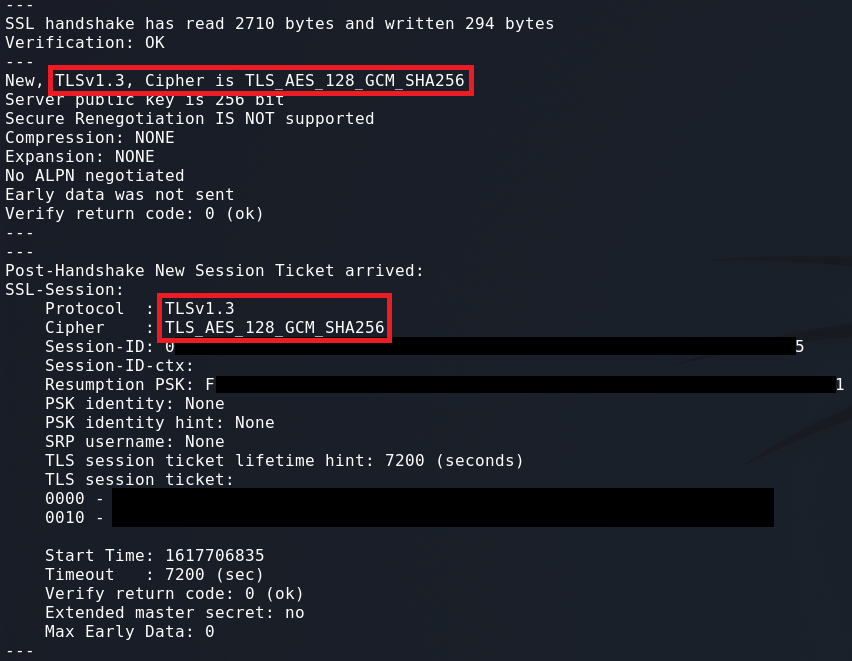

- Openssl test tls 1.2 with cert for free#
- Openssl test tls 1.2 with cert manual#
- Openssl test tls 1.2 with cert download#
These names are often used interchangeably which can lead to some confusion:Ī configuration that uses the SSL protocol (SSLv2/SSLv3) is insecure. Secure Sockets Layer (SSL) is the predecessor of the TLS protocol. It is used most commonly in web browsers, but can be used with any protocol that uses TCP as the transport layer. It provides integrity, authentication and confidentiality. Transport Layer Security (TLS) provides security in the communication between two hosts.

You can combine your certificate with a third-party intermediate certificate with: $ cat gd_bundle-g2-g1.crt > If this is the case, you must combine the two certificate files into one, so the email service can process them both in combination.
Openssl test tls 1.2 with cert download#
Many SSL vendors also require you to download an intermediate certificate. The certificate will be accessible as a file (such as ). If you purchase a certificate from a vendor, it will ask you to upload that CSR to its system, as it is used as the input to generate the SSL/TLS certificate. Now you have the two files needed to configure your email services for enhanced security: the private key file,, and the public certificate file,. Using the CSR file from the steps above, you can request a new certificate to be generated and signed by the root CA you just created: $ openssl x509 -req -in -CA m圜A.pem -CAkey m圜A.key -CAcreateserial -out -days 1825 -sha256Įnter your private root CA key passphrase to create and sign the certificate. Next, generate the root CA certificate: $ openssl req -x509 -new -nodes -key m圜A.key -sha256 -days 1825 -out m圜A.pemĪfter answering a few more questions, you will generate a root CA certificate with a five-year lifespan. Please give it a secure passphrase and don't lose it-this is your private root CA key, and as the name states, it's the root of all trust in your certificates. You can create your own root CA with: $ openssl genrsa -des3 -out m圜A.key 2048 If you want to generate your own certificate, you must create your own root CA before issuing the CSR command above. Once you have filled out the information, the key and CSR will be generated. The process will ask you a number of questions associated with the certificate: location details, server fully qualified domain name (FQDN), email contact information, etc. This command will create a new CSR and private key at the same time for the service you are trying to secure. In either case, the process to start requesting a new certificate is to use the OpenSSL tooling on your Linux system to create a certificate signing request (CSR): $ openssl req -new -newkey rsa: 2048 -nodes -keyout -out But if you're rolling this out to a large group or have paying customers, then you're better served by purchasing a certificate from a public, trusted company that sells them. If your use case is private or for testing, then saving money with a self-generated certificate makes sense.
Openssl test tls 1.2 with cert manual#
In the past, generating your own certificate was easy and worked in most cases, but with the increasing demand for better security, most email clients don't trust self-generated SSL/TLS certificates without a manual exception.
Openssl test tls 1.2 with cert for free#
SSL/TLS certificates can be generated for free using tools like OpenSSL, or they can be purchased for a range of prices from public certificate authorities (CAs). At a high level, SSL/TLS encryption is a public/private encryption algorithm.īy adding these security features into the services, they can listen on new TCP ports: Service How SSL/TLS encryption secures information is beyond the scope of this article, but Bryant Son's internet security article covers it in great detail. To protect the email data and authentication, these services have added a security feature in which they can utilize an SSL/TLS certificate to wrap the data flow and communication with encryption. All of these services, by default, send your email and authentication to/from these services in plain text-thus, it's very unprotected! Once an email is on the email server, it is retrieved using one of two services: Internet Message Access Protocol (IMAP) using port TCP 143, or Post Office Protocol (POP3) using port TCP 110. This protocol sends emails from server to server based on DNS mail exchanger (MX) record lookups. Email is sent via a service called Simple Mail Transport Protocol (SMTP) using TCP port 25.


 0 kommentar(er)
0 kommentar(er)
